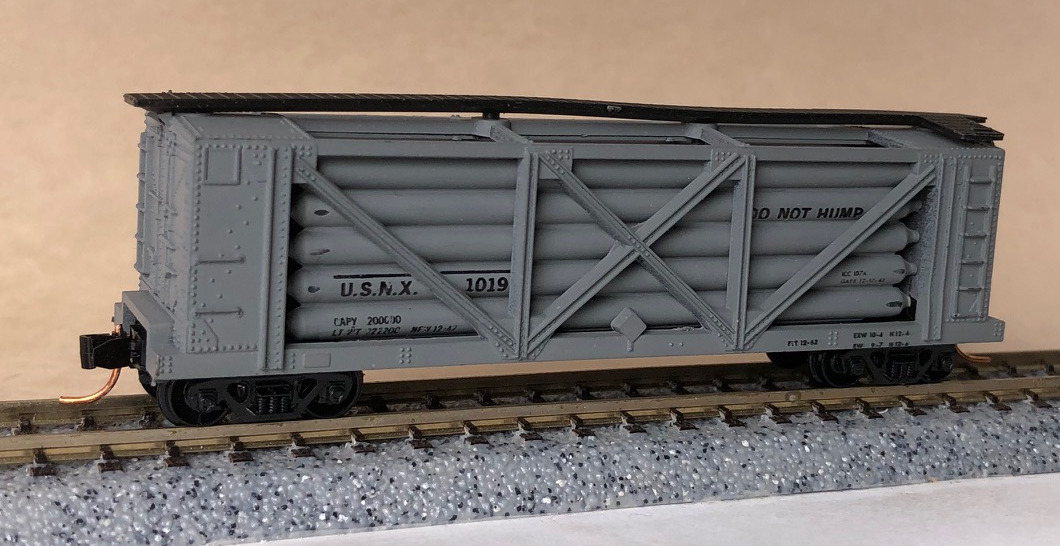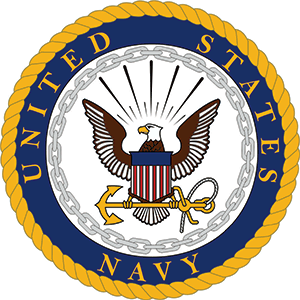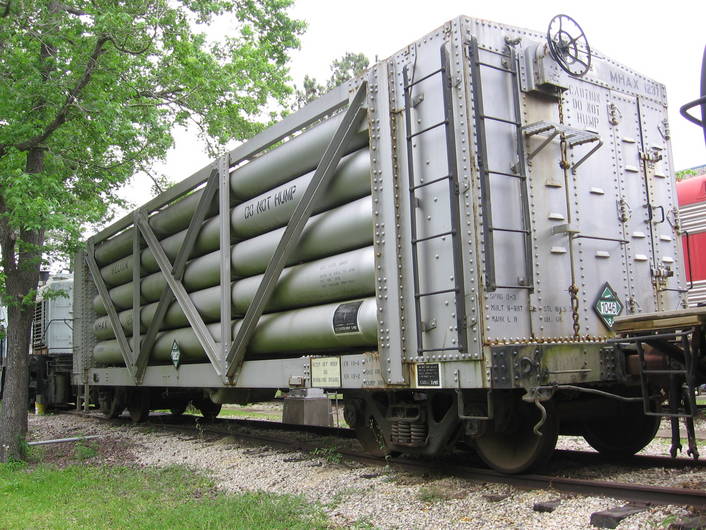Model Information: This body style was created for Atlas by Roco in the late 1960s. Atlas released a series of four cars using this tooling in 1969. Atlas never did a second production run - presumably because it did not sell that well. 26 years later, E-R models contracted with Roco to produce a second run of these cars with the same road names as the Atlas run but with three new road numbers. For some reason, E-R did not re-run the Department of Mines paint scheme.
Again, these cars disappeared from the marketplace (other than eBay) for another 20 years. In 2016, Micro-Trains mysteriously produced a new run of this tooling with a Weathered NASA paint scheme as part of their NASA car series. This was followed up by another Micro-Trains Special run in 2017 of two glow-in-the-dark cars commissioned by Fred Hoxsie of the NSE.
These cars are rather unique in both the prototype and the N Scale world. So my curiosity was piqued at how a long-deceased manufacturer (Roco) suddenly started producing cars from a presumed lost tooling. So I asked Fred Hoxsie, "Where did you get these? I thought Roco was long gone and that their older toolings from the 1960s were long-lost." Fred responded "I haven't a clue - ask Eric." So I trotted over to the Micro-Trains booth at the NSE event in Pittsburgh and asked Eric Smith himself, "Hey Eric, where did these cars come from?".
Eric explained that whomever had acquired the assets of Roco when they went belly-up was not not sure what to do with the various inventory acquired during the bankruptcy. Currently, Modelleisenbahn GmbH owns the Roco brand name, but bankruptcies can be complex, and the older Roco inventory might have ended up just about anywhere (perhaps Roco owed their lunch caterer some Euros?). Micro-Trains got in contact with whomever took ownership of this model and bought the inventory of unpainted bodies. It was one of Eric's minions who negotiated the deal and he was a little fuzzy on the details, but if I got it right, MTL acquired a pallet of these cars (but not the tooling) and will release them periodically as special and/or regular releases. I neglected to ask how many MTL acquired, so I cannot predict how many more we will see.
Again, these cars disappeared from the marketplace (other than eBay) for another 20 years. In 2016, Micro-Trains mysteriously produced a new run of this tooling with a Weathered NASA paint scheme as part of their NASA car series. This was followed up by another Micro-Trains Special run in 2017 of two glow-in-the-dark cars commissioned by Fred Hoxsie of the NSE.
These cars are rather unique in both the prototype and the N Scale world. So my curiosity was piqued at how a long-deceased manufacturer (Roco) suddenly started producing cars from a presumed lost tooling. So I asked Fred Hoxsie, "Where did you get these? I thought Roco was long gone and that their older toolings from the 1960s were long-lost." Fred responded "I haven't a clue - ask Eric." So I trotted over to the Micro-Trains booth at the NSE event in Pittsburgh and asked Eric Smith himself, "Hey Eric, where did these cars come from?".
Eric explained that whomever had acquired the assets of Roco when they went belly-up was not not sure what to do with the various inventory acquired during the bankruptcy. Currently, Modelleisenbahn GmbH owns the Roco brand name, but bankruptcies can be complex, and the older Roco inventory might have ended up just about anywhere (perhaps Roco owed their lunch caterer some Euros?). Micro-Trains got in contact with whomever took ownership of this model and bought the inventory of unpainted bodies. It was one of Eric's minions who negotiated the deal and he was a little fuzzy on the details, but if I got it right, MTL acquired a pallet of these cars (but not the tooling) and will release them periodically as special and/or regular releases. I neglected to ask how many MTL acquired, so I cannot predict how many more we will see.
Prototype History: The 13 NASA helium cars were some of the heaviest cars ever made, weighing in at 240,300 pounds empty and had a 28,000 pound load limit. Built in 1961, these cars were initially used by the BLM to transport helium from mines in Texas. Later, they found their niche servicing NASA Titan rockets and the Space Shuttle up until the last Shuttle flight in 2011.
A few cars have been repurposed for use in the Space X engine test complex outside McGregor, Texas. Eight other cars were transferred to California and are on lease tro support the Space X Falcon 9 Launch Complex at Vandenberg Air Force Base.
A few cars have been repurposed for use in the Space X engine test complex outside McGregor, Texas. Eight other cars were transferred to California and are on lease tro support the Space X Falcon 9 Launch Complex at Vandenberg Air Force Base.
Road Name History: The United States Navy (USN) is the naval warfare service branch of the United States Armed Forces and one of the seven uniformed services of the United States. The U.S. Navy is the largest, most capable navy in the world, with the highest combined battle fleet tonnage. The U.S. Navy has the world's largest aircraft carrier fleet, with eleven in service, one in the reserve fleet, and two new carriers under construction. The service has 322,421 personnel on active duty and 107,577 in the Navy Reserve. It has 276 deployable combat vessels and more than 3,700 operational aircraft as of June 2017.
The United States Navy claims 13 October 1775 as the date of its official establishment, when the Second Continental Congress passed a resolution creating the Continental Navy. With the end of the American Revolutionary War, the Continental Navy was disbanded. Under first President George Washington threats to American merchant shipping by Barbary pirates from four North African Muslim States, in the Mediterranean, led to the Naval Act of 1794, which created a permanent standing U.S. Navy. The original six frigates were authorized as part of the Act. Over the next 20 years, the Navy fought the French Republic Navy in the Quasi-War (1798–99), Barbary states in the First and Second Barbary Wars, and the British in the War of 1812. After the War of 1812, the U.S. Navy was at peace until the Mexican–American War in 1846, and served to combat piracy in the Mediterranean and Caribbean seas, as well fighting the slave trade off the coast of West Africa. In 1845, the Naval Academy was founded at old Fort Severn at Annapolis, Maryland by the Chesapeake Bay. In 1861, the American Civil War began and the U.S. Navy fought the small Confederate States Navy with both sailing ships and new revolutionary ironclad ships while forming a blockade that shut down the Confederacy's civilian coastal shipping. After the Civil War, most of the its ships were laid up in reserve, and by 1878, the Navy was just 6,000 men.
From Wikipedia
The United States Navy claims 13 October 1775 as the date of its official establishment, when the Second Continental Congress passed a resolution creating the Continental Navy. With the end of the American Revolutionary War, the Continental Navy was disbanded. Under first President George Washington threats to American merchant shipping by Barbary pirates from four North African Muslim States, in the Mediterranean, led to the Naval Act of 1794, which created a permanent standing U.S. Navy. The original six frigates were authorized as part of the Act. Over the next 20 years, the Navy fought the French Republic Navy in the Quasi-War (1798–99), Barbary states in the First and Second Barbary Wars, and the British in the War of 1812. After the War of 1812, the U.S. Navy was at peace until the Mexican–American War in 1846, and served to combat piracy in the Mediterranean and Caribbean seas, as well fighting the slave trade off the coast of West Africa. In 1845, the Naval Academy was founded at old Fort Severn at Annapolis, Maryland by the Chesapeake Bay. In 1861, the American Civil War began and the U.S. Navy fought the small Confederate States Navy with both sailing ships and new revolutionary ironclad ships while forming a blockade that shut down the Confederacy's civilian coastal shipping. After the Civil War, most of the its ships were laid up in reserve, and by 1878, the Navy was just 6,000 men.
From Wikipedia
Brand/Importer Information: In 1924 Stephan Schaffan, Sr. founded the Atlas Tool Company in Newark, New Jersey. In 1933 his son, Stephan Schaffan, Jr., came to work for his father at the age of sixteen. Steve Jr. built model airplanes as a hobby and frequented a local hobby shop. Being an enterprising young man, he would often ask the owner if there was anything he could do to earn some extra spending money. Tired of listening to his requests, the hobby-store owner threw some model railroad track parts his way and said, "Here, see if you can improve on this".
In those days, railroad modelers had to assemble and build everything from scratch. Steve Jr. created a "switch kit" which sold so well, that the entire family worked on them in the basement at night, while doing business as usual in the machine shop during the day.
Subsequently, Steve Jr. engineered the stapling of rail to fiber track, along with inventing the first practical rail joiner and pre-assembled turnouts and flexible track. All of these products, and more, helped to popularize model railroading and assisted in the creation of a mass-market hobby. The budding entrepreneur quickly outgrew the limitations of a basement and small garage operation. Realizing they could actually make a living selling track and related products, Steve and his father had the first factory built in Hillside, New Jersey at 413 Florence Avenue in 1947. On September 30, 1949, the Atlas Tool Company was officially incorporated as a New Jersey company.
In 1985, Steve was honored posthumously for his inventions by the Model Railroad Industry Association and was inducted into the Model Railroad Industry Hall of Fame in Baltimore, Maryland. In addition, Steve was nominated and entered into the National Model Railroad Association Pioneers of Model Railroading in 1995.
In the early 1990s, the Atlas Tool Company changed its name to Atlas Model Railroad Company, Inc.
In those days, railroad modelers had to assemble and build everything from scratch. Steve Jr. created a "switch kit" which sold so well, that the entire family worked on them in the basement at night, while doing business as usual in the machine shop during the day.
Subsequently, Steve Jr. engineered the stapling of rail to fiber track, along with inventing the first practical rail joiner and pre-assembled turnouts and flexible track. All of these products, and more, helped to popularize model railroading and assisted in the creation of a mass-market hobby. The budding entrepreneur quickly outgrew the limitations of a basement and small garage operation. Realizing they could actually make a living selling track and related products, Steve and his father had the first factory built in Hillside, New Jersey at 413 Florence Avenue in 1947. On September 30, 1949, the Atlas Tool Company was officially incorporated as a New Jersey company.
In 1985, Steve was honored posthumously for his inventions by the Model Railroad Industry Association and was inducted into the Model Railroad Industry Hall of Fame in Baltimore, Maryland. In addition, Steve was nominated and entered into the National Model Railroad Association Pioneers of Model Railroading in 1995.
In the early 1990s, the Atlas Tool Company changed its name to Atlas Model Railroad Company, Inc.
Manufacturer Information:  The company was founded in 1960 by Ing. Heinz Rössler and started with a plastic Minitanks series of military vehicles. After export to the USA became successful, the model line was expanded with model trains in HO scale and the smaller N scale. TT scale was also subsequently added to the product line. The model rail product line covers many European countries including Germany, Belgium, Luxembourg, France, Spain, Austria, Italy, Switzerland, Sweden and the Netherlands, and also the USA.
The company was founded in 1960 by Ing. Heinz Rössler and started with a plastic Minitanks series of military vehicles. After export to the USA became successful, the model line was expanded with model trains in HO scale and the smaller N scale. TT scale was also subsequently added to the product line. The model rail product line covers many European countries including Germany, Belgium, Luxembourg, France, Spain, Austria, Italy, Switzerland, Sweden and the Netherlands, and also the USA.
On July 15, 2005 ROCO Modellspielwaren GmbH was declared bankrupt. From July 25 the company continues as Modelleisenbahn GmbH, but still uses the Roco brand and associated logo. On October 1, 2007, distribution of the 'Minitank' product series was assigned to the German model car manufacturer Herpa.
Since February 2008 Modelleisenbahn also owns Fleischmann, which like Roco had gone bankrupt. The two companies continue as separate brands under Modelleisenbahn GmbH, while benefiting from economies of scale through joined development projects, marketing and procurement.
From Wikipedia

On July 15, 2005 ROCO Modellspielwaren GmbH was declared bankrupt. From July 25 the company continues as Modelleisenbahn GmbH, but still uses the Roco brand and associated logo. On October 1, 2007, distribution of the 'Minitank' product series was assigned to the German model car manufacturer Herpa.
Since February 2008 Modelleisenbahn also owns Fleischmann, which like Roco had gone bankrupt. The two companies continue as separate brands under Modelleisenbahn GmbH, while benefiting from economies of scale through joined development projects, marketing and procurement.
From Wikipedia
Item created by: gdm on 2016-03-03 08:07:41. Last edited by gdm on 2020-06-06 08:48:41
If you see errors or missing data in this entry, please feel free to log in and edit it. Anyone with a Gmail account can log in instantly.
If you see errors or missing data in this entry, please feel free to log in and edit it. Anyone with a Gmail account can log in instantly.











